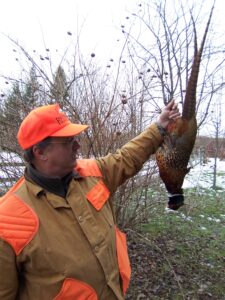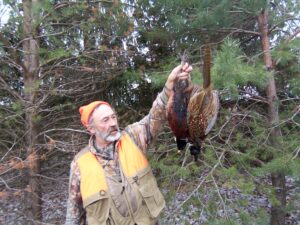
Author’s buddy with a ringneck harvest
Native only to Asia, the pheasant can be found in many parts of the world today, primarily due to the fact it is an outstanding upland gamebird. It belongs to the Order Galliformes, the same as as chickens and peacocks, a couple of reasons rooster pheasants are not only colorful, but a delight to eat as well. The first official release of pheasants in Michigan occurred in 1917, which were already hybrids from game farms involving Chinese ringneck and Mongolian blood. Subsequent private releases from hunting clubs as well as escapees from game preserves would add more to Michigan’s wild pheasant hybrid gene pool.
During the late 1980’s and early 1990’s the MDNR released “black-necked” pheasants in the Thumb with the hopes of having a pheasant which could readily survive in a habitat-limited and intensely farmed agricultural area. These were birds with direct bloodlines to wild pheasants from the Sichuan Province of China, which apparently did well in a similar atmosphere. While the program wasn’t a great success, it did add more to the wild ringneck gene pool, and adding new wild genes wasn’t a bad thing.
What I noticed about the Sichuan influence was a change in coloration of the spurs on wild roosters, which had usually always been ebony, and are now occasionally ivory, as well as some roosters have a green sheen to their breast feathers and the typical powder blue on their lower back will be an almost emerald green. Yep, folks, I’ve been pursuing local wild ringnecks since I was a kid, and readily witnessed some changes during certain timeframes.
One gene which remains very prominent in our local hybrid pheasant population is that of the Chinese ringneck, and it is rare to shoot a wild rooster which doesn’t t have a white band around its neck. In any event, I believe the wild Thumb pheasants are truly unique due to their multiple bloodlines, and they are certainly adaptable if the right habitat is provided, something I’ve been trying to do on our family farm for more than a couple decades.

…another ringneck harvest among the ensemble of hunters
When local agriculture practices started making dramatic and widespread changes during the 1960’s which removed pheasant habitat, Thumb pheasant numbers quickly declined, but survivors hung on, and could be still found in areas where habitat, as limited as it was, provided birds with what they needed. Never giving up on Thumb pheasant hunting, I would spend the next 20 years hunting untilled small pockets of cover, ditch banks, fencerows and hayfields. All I can say is it was a lot of walking for each rooster taken and, since most folks believed pheasant hunting had faded away, I usually had the field all to myself.
It was during the 1980’s when CRP came into the picture which placed a lot of Thumb farmland acres into grasslands, and local wild pheasants started immediately responding. One of the farmers putting in CRP ground was my late Uncle Harland Lounsbury, and I learned a lot from his example, as I witnessed firsthand what the cover he provided did for local birds. The conservation efforts I now do on our own land, I learned from him, and he helped me plant most of it.
During the early days of CRP, cold season grasses such as brome and orchard grass were popular for cover, and they do become established to provide cover quite quickly. The best cover, however, is warm season prairie grasses which have a longer lasting effect and stand up better during the winter than cold season grasses, and this is the conservation practice I continue to follow.
Prairie grass, however, requires patience, because it takes awhile to set its roots properly and become established. I can remember wondering for two years after it was planted if my prairie grass (and wildflowers) was ever going to become what it was supposed to be. It was in the third year it proved to me it was, and we’ve had excellent cover for more than 20 years now, not only for pheasants, but also for all wildlife from deer and wild turkeys to songbirds and even insects such as butterflies and grasshoppers (insects are an extremely important source of protein for wild chicks).
Prairie grass, of which there are several types, does require routine maintenance, otherwise it thatches up and becomes frowzy, and I’ve found fire (I prefer prescribed burns performed by a professional) is the best, because that is what nature intended. Prairie grass starts getting frowzy in about five years and after a burn it is truly amazing to watch the steady transition of a charred black field which greens up, then becomes covered in wildflowers that are soon enveloped in tall prairie grass. Of course, the local wild pheasants always appreciate it.
I have three fields enrolled in CRP, and this spring, due to mid-management CRP requirements, I had two of them ground down with a masticator due to a heavy influx of autumn olive and the third was burned. All three fields responded splendidly to both methods and I presently have outstanding cover, some of which is at least 8 feet high! Yep, folks, this created a very challenging environment to pursue wild ringneck roosters in. I do know for a fact that more roosters went readily into the bag when my cover was only marginal while becoming first established, but today, it requires serious determination and good dogs to corner wily roosters in a large block of dense cover entailing “the long grass”.
A real beauty about my local pheasant hunting is besides the first season (October 20 – November 14) there is the also the December season (December 1 – January 1) and each season offers its own unique atmosphere, and I truly appreciate the additional time to be in the field. After over 60 years of hunting wild Thumb ringnecks, I can state for a fact that taking excess roosters (which have an average lifespan of one year – and only roosters are legal to shoot) has no impact on pheasant numbers the following year, because 80% to 90% of roosters harvested each year, were hatched that summer, and there are always plenty of roosters left over from the previous hunting seasons to take care of matters during the spring breeding season.
Of the two seasons, December has become my favorite, when I appreciate the fact that most crops have been harvested, whereas in October, crop fields such as corn or soybeans offer a quick haven for roosters when shotguns start booming. Also, young (late hatch) roosters not fully “colored out” in October, will be in “full bloom” in December and therefore easier to identify. I’ve heard it said by some folks that December pheasant hunting must be way too easy and a detriment to the species, but the reverse is true. The winter weather can get a tad testy and there are no dumb roosters, if there ever was such to begin with.
Yep, folks, wild ringneck numbers are up this year and I do plan on taking advantage of that fact whenever possible for the rest of the year.

